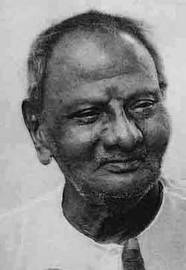“When I see I am nothing, that is wisdom. When I see I am everything, that is love. My life is a movement between these two.” – Nisargadatta
Nisargadatta here summarizes one of the central insights articulated in the Upanishads. He speaks of wisdom or knowledge associated with a negative realization, the realization of what one is not. He also speaks of love associated with the positive realization of what one is. He speaks of his life as a movement between each, for life may be lived in such a way that the wisdom gained by understanding what we are not gives rise to the loving understanding of what we are. Having divested ourselves of the understanding that we are the limited mind, body, or mind-body, we are situated to see that we are a vaster Self present and experienced in all things.
The Path of Exclusion
“To see that one is nothing” doesn’t mean “to see oneself as non-existent.” It’s rather to see one’s no-thingness, seeing that essentially we are not the limited being we believe ourselves to be. More specifically, it’s to see that the real self is not the mind-body or any of its many manifestations or roles: man, woman, son, father, mother, student, professor, lawyer, American, Californian, Democrat, Republican, Christian, Jew, Hindu, Buddhist, etc. I am not what is thought in thinking. I am not what is perceived in perceiving. I am not what is sensed in sensing. I am not the body, which appears as the object of my thinking, perceiving, and sensing. To see that one is no-thing is to dissolve the sense of self that is rooted in attachments to the non-enduring objects of sense experience. This “path of exclusion” involves a dismantling of a false conception of the self that has arisen from identification with the body-mind. The Upanishads directs us to this understanding of our essential nature by the phrase neti neti (not this, not that), that is, “I am not this thing” and “I am not that thing.”
Then what?
When the subject is divested of an identity forged in relation to an ostensibly independently existing world of outer objects, the true subject itself is revealed or realized. I am not my thinking, perceiving, or sensing. I am that which is aware of them. The only enduring feature of experience is the atman, pure awareness, the ever-present, witnessing background of all experience. This is the “I” that remains once the I (of the false ego) is dissolved. In this way, the path of exclusion brings one to the knowledge of the true, enduring Self.
The Path of Inclusion
However, what is given in the knowledge that one is pure awareness is not the knowledge of the nature of this pure awareness. This remains to be explored as a second movement after the path of exclusion. We can speak of it as a “path of inclusion.” Here the Self, initially distinguished from the world, returns to the world and ultimately sees all things as manifestations of the Self. The return to the world of objects commences with the exploration of our experience. It is to ask, what is known in the thinking? What is known in the perceiving? What is known in the sensing? It is to see, after careful engagement, that there is nothing in the experience other than the knowing of it. In the perception of the tree, there is nothing but the knowing of it. In the sensation of heat, there is nothing but the knowing of it. In the thought of one’s name, there is nothing but the knowing of it. Experience itself is made of nothing but the knowing of it.
“To see that one is everything” is just to see that everything is made out of the awareness that is oneself. However, never coming to be nor ceasing to be, this awareness is ever-present, without origin, and eternal. Having no boundaries, it is boundless. Having no limit, it is limitless or infinite. The Self does not partake of the destiny of either the body or the mind, but is witness to their birth and witness to their ultimate dissolution.
The Path of Love
This path of inclusion may be understood as “the path of love,” and from this love all compassion freely flows.
First, from the viewpoint of the Upanishads, the heart of all suffering is resistance, and resistance arises from subject-object duality. I can only experience resistance if there is the perception of some thing other than myself. There can be no resistance in non-duality. Thus non-duality is peace, completeness, satisfaction, or the absence of wanting or needing. Otherwise put, suffering arises from resistance born of the separation between the knower and what is known (being). Ananda (bliss or love) may therefore be understood as the union or non-separateness of knowing and being.
Second, love is the outflowing of one’s being that produces the infinite variety of the objects of experience. They are so many manifestations of the love that is oneself. But love is also the inflowing of one’s being back into awareness, for in the realization that “the object” is really a form of the “subject,” the object as a mere object dissolves. Love, divested of its object, falls back into the Self from which it originated. Hence, as the Upanishads state, all things arise from love, evolve through love, and dissolve into love. You are that love, the fountain of compassion guided by wisdom.
Michael Sudduth

 Follow
Follow